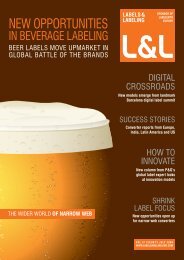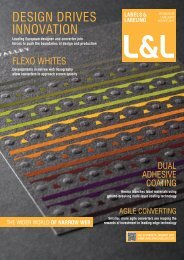THE DATA FRONT
Download as PDF - Labels & Labeling
Download as PDF - Labels & Labeling
- No tags were found...
Create successful ePaper yourself
Turn your PDF publications into a flip-book with our unique Google optimized e-Paper software.
82 | l&l<br />
All change<br />
on the data front<br />
Barry Hunt examines item-level RFID tags and<br />
developments in printed electronics for logistics labeling<br />
Logistics labeling is a fancy way to describe the many types of<br />
labels, swing tickets and tags that include some type of variable<br />
information printing. This can include scannable barcodes,<br />
variable text, sequential numbering and batch codes, usually<br />
printed by digital laser, inkjet or thermal transfer as part of<br />
in-line or off-line production processes. Many end-users, but<br />
some trade printers too, print standard-sized logistics labels on<br />
stand-alone thermal or laser printer/encoders to suit on-demand<br />
needs. But beyond these well-proven production methods lies<br />
Labels&Labeling<br />
an alternative world of complimentary technologies.<br />
Barcoding, in particular, is undergoing several important<br />
changes. Notable among them is the GS1 DataBar code. (GS1<br />
is a global standards-setting organization based in Brussels.)<br />
Formerly called the Reduced Space Symbology (RSS) code, it<br />
is expected to become widely adopted internationally by brand<br />
owners and packaging designers. Compared with traditional<br />
EAN and UPC barcodes, DataBar codes contain more data and<br />
can be printed in much smaller sizes for items ranging from fruit
















